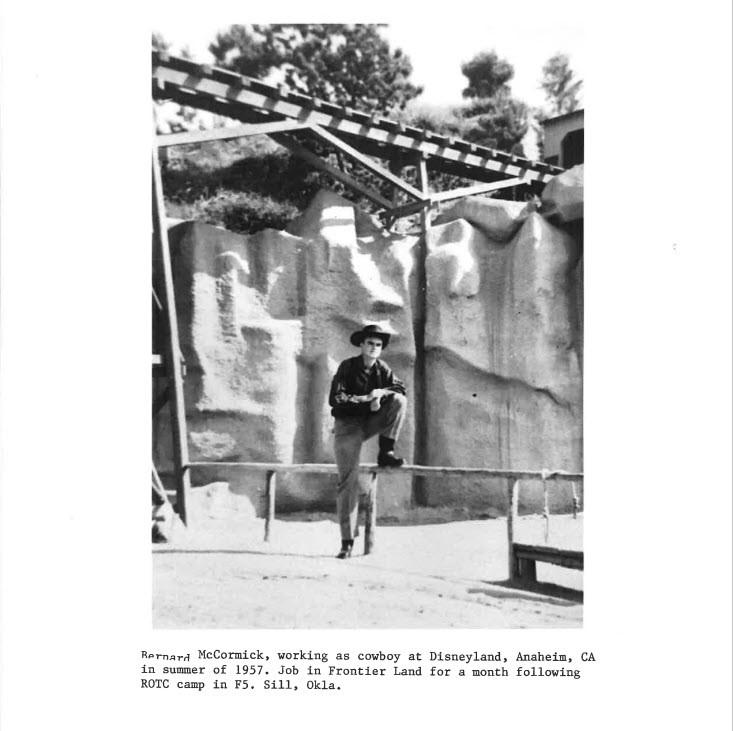Sunday night the Miami Dolphins will celebrate the 50th anniversary of their 1972 team, the only team ever to go undefeated in the National Football League. That team remains unique after all these years, and on this anniversary, it is well to recall that it is distinguished for another quality. In a word - class.
It begins with the owner, Joe Robbie. He is the man who spent the money to acquire the best young coach in football: Don Shula. Shula had built the Baltimore Colts into a power. In contrast, the Dolphins had been one of the worst teams in pro football, but Shula recognized the nucleus for a winner and quickly made it one. He put together a great coaching staff and demanded his players realize their potential. The first year was 10-4, and South Florida began to take notice. So did our Gold Coast magazine, which we took over that year. We were trying to convert a social magazine (the original name was Pictorial Life) which featured people dancing for disease, into a broader appeal regional book. Sports stories were a natural addition.
The Dolphins got off to a fast start in 1971, winning seven of their first nine games. Fans began to get excited about their prospects, and we decided to jump on the bandwagon. It was past mid-season before we began hanging around practice sessions, picking the brains of the beat reporters, and went on the road with the team to Baltimore, where they won a tough game, and then to Boston. It was a cold day in Foxboro, and the Dolphins did not play well, losing 34-13. But the game provided two memorable moments. Power fullback Larry Csonka fumbled for the only time all season, and a Boston freelance photographer, whose name has been lost, took our all-time favorite photo in Gold Coast's 50 year history. It was Shula leading his team onto the field, the determination on their faces suggesting a charge to destiny. That came the following year.
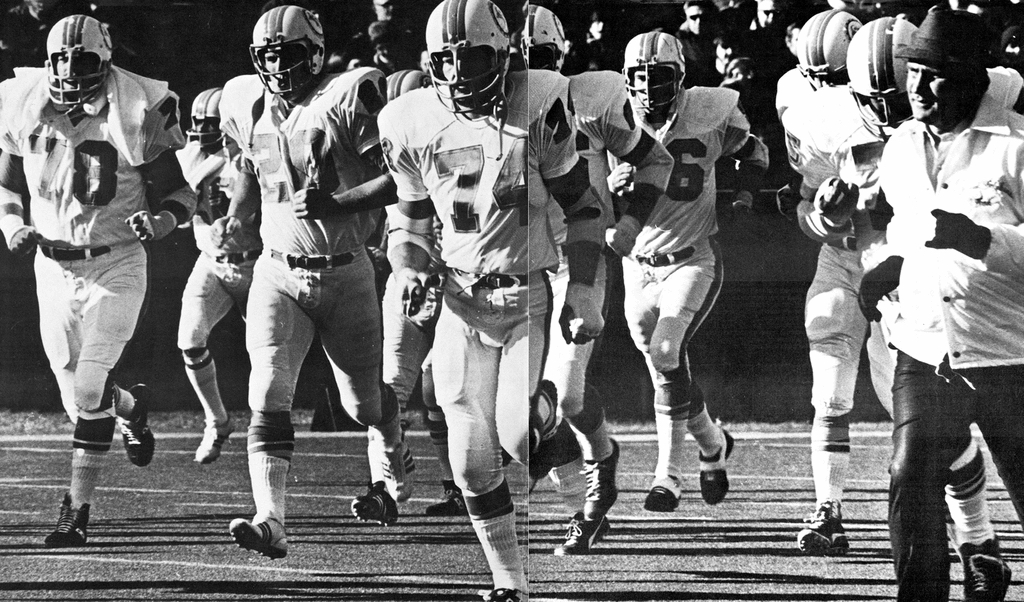
That team won a second Super Bowl the next year, with essentially the same coaches and players. And what an organization they turned out to be. Owner Joe Robbie built a modern stadium with his own money. He had a checkered reputation, and some publicized family problems, not helped by a fondness for alcohol. But over their long association, he let Don Shula have a major hand in running the football business as one of the most successful in sports history. In that respect, he was a class owner.
Shula's reputation needs no embellishments. A control freak and hard driving coach, he was also fair. A Philadelphia sports writer said when it came to all aspects of the job, including tactful handling of the press, Shula was the best. He rarely said anything stupid, at least not for publication. He became one of South Florida's most respected figures. His assistants on the undefeated team reflected his example. The offensive coordinator Howard Schnellenberger went on to lead the University of Miami to a national championship, and later put Florida Atlantic on the football map, first as its founding coach, then as the fundraiser for a campus stadium. And he did it all with grace and class. Defensive coordinator, Bill Arnsbarger, went on to a long career as a coach and later athletic director at the University of Florida when the school's athletic program needed a strong reformer.
A number of players on the ’72 team are still considered among the best all-time at their positions, including Hall of Famers Larry Csonka, quarterback Bob Griese, receiver Paul Warfield, and linemen Jim Langer, Nick Buonoconti, and Larry Little. Many of that team left the area after their playing days, but those who remained were often in the limelight. Among them: Bob Griese as a sports announcer, Buonoconti as a business lawyer and philanthropist, fellow Notre Damer Bob Kuchenberg as an art dealer, and Earl Morrall as an assistant coach at the University of Miami and later mayor of Davie. Others still remembered are Csonka as spokesman for Alaska outdoor life and Mercury Morris for his affectionate support for Jim Kiick during his fight against football related brain trauma.
Keep in mind that this was a time before the huge sports salaries. A football player did not make more than an average crooked lawyer. The men needed to work after football.
Almost all of the team members were successful in later life. A prime example is a player not often in the press. Doug Swift was probably the least known member of the Dolphins “no name defense.” Most of the key players on the team were college stars, but Swift played at Amherst, known more for academics that sports. He reached the pros almost on a lark, when his college coach told him he might be good enough. He first went to Canada, where the coach did not have room for him, but suggested he try Miami, where Don Shula was building a promising team. Swift did, made the team in 1970 and was a starting linebacker for six seasons.
He had another career on his mind. Both his parents were physicians and he was one of the smartest and classiest guys on a team of smart and classy people. He took pre-med courses while playing football – quite a feat. He was the only player we really got to know. We ran a piece about this unique pro in Miami Magazine, which we owned at the time. It was remarkable for its candor. He described the feeling of being on the bottom of the pile and body after body thudding as they fell on top, and wondering what was the meaning of it all. And he spoke of resentment of the long prayers and political speeches before playoff games.
Little was heard from him after football, until the mid-1980s when Dr. Doug Swift got a brief mention in the Philadelphia papers for a former pro footballer being the anesthesiologist in the first heart transplant procedure in that city. It got no notice in South Florida, until we contacted him and he arranged for us to watch him in an open heart surgery at Temple University Hospital. If a story ever wrote itself, that one did. It ran in Tropic, the Miami Herald’s Sunday magazine.
Dr. Swift is expected to be among the men honored Sunday night for an historic first and only feat in football history. When those aging former players take the field at halftime, fans will salute more than just the men who made sports history. They will also be honoring class.
When we moved to Florida in 1971, a number of people told us that we were smart to buy in Fort Lauderdale's old Colee Hammock neighborhood. Our house was reportedly 18 feet above sea level and even though we were only a mile from the beach we were high enough to ride out hurricanes with minimal threat, at least from flooding. The only obvious hazards were the old oak trees which could come down in high winds, but that did not happen often. Those trees had been around for a hundred years and sometimes much more. They had seen a storm or two. It was not our principal motive for purchasing there, but it was a reassuring factor.
We had been looking to the west, where most young families were moving at the time, but we were also advised that much of that land was low lying, and prone to flooding. If it seems strange that we were getting such advice 50 years ago, keep in mind that Fort Lauderdale's downtown had seen flooding in the 1960s and people who had been here for a while were quite aware of the water danger when hurricanes came. Since then, various flood control measures, improved drainage and pumping, have been put in place, and people tend to forget the advice about location that we were fortunate to hear five decades ago.
That advice is still useful. People who care about what's going on in Fort Lauderdale know the neighborhood’s at risk. Some of them are very expensive waterfront properties, notably the south side or Las Olas Boulevard. And, as the Sun Sentinel has recently observed, overbuilding in the downtown has the dual effect of paving over land that could absorb water, at the same time exposing greater numbers of people to the dangers of high wind and water. And it can happen, as we learned in 2004 when the freakish hurricane Wilma came through from the west, complete with tornados that did a pretty good job of damaging both buildings and homes unlucky enough to get hit. That included this writer's home which saw an old oak (42 inches at its base) snap about eight feet up and land on our roof. Fortunately the thick branches cushioned the blow, resulting in only three patchable holes. And we were lucky to be home to bale out the water as fast as it poured in.
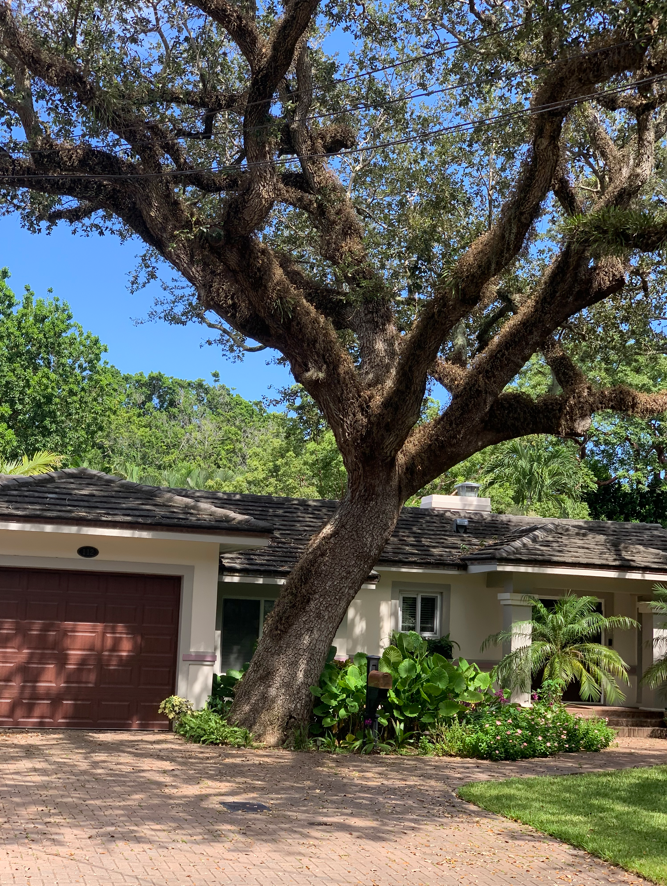
Colee Hammock is known for classic old oaks and high elevation
Our point, of course, relates to the disaster called Ian and the huge number of people who have moved into Gulf Coast communities long recognized as prone to flooding in a major storm. Flood damage is not a rarity. Recent years have seen its effects on Florida's Panhandle, Louisiana and Texas. Florida's southwest coast had been hit hard in the not too distant past, and it was only a matter of time before a really big one would arrive. You have to ask if the builders and real estate people, who certainly knew the score, warned buyers of the dangerous locations - near shallow water posing the risk of storm surge. Judging by the fact that so few had flood insurance suggests the new residents, which are the great majority of people there, were not aware of what they were buying into.
We have seen the pathetic testimony of people who have lost everything and have no insurance or personal resources to recover. At least part of that burden is going to fall on all of Florida and the federal government. We wonder if that is fair to people who bought property more thoughtfully to pay for those who did not? And what about rebuilding? Many of those on Sanibel and Captiva have money, and can afford to rebuild even without government help. But that is not true for people in less expensive towns that were savaged. And should those places even rebuild? And if so, should they not be constructed to withstand the worst case storm such as Ian - those once-in-a-hundred-year events that, if climate change continues at the present pace, may be more like once in a decade? The Jersey Shore has already seen construction of beachfront houses built on stilts to avoid storm surges, but that is a costly remedy that few of Ian's victims can afford.
An irony of all this is that there has been relief that the storm did not hit Tampa Bay as originally projected. The loss would have been much worse. And yet that already highly populated area is expected to grow even faster in the next few years. The worst may be yet to come.
Perhaps what we need are more people who give newcomers the advice we were lucky to get 50 years ago. When it comes to hurricanes, buyers beware.
Florida Bulldog, the independent investigative reporting group founded by Dan Christensen, has often made news over its 13-year history. But that news rarely gets picked up by newspapers, even when it has high local interest. An exception was recently when the Sun Sentinel, in a major story on embattled Broward County Sheriff Greg Tony, gave Florida Bulldog a one-sentence credit for originating the story. Dan Christensen discovered in 2020 that Tony had not revealed during his police career that he had been suspected of murdering a fellow teenager in Philadelphia in 1993. That should have disqualified Tony from ever becoming a police officer, much less sheriff of a large county.
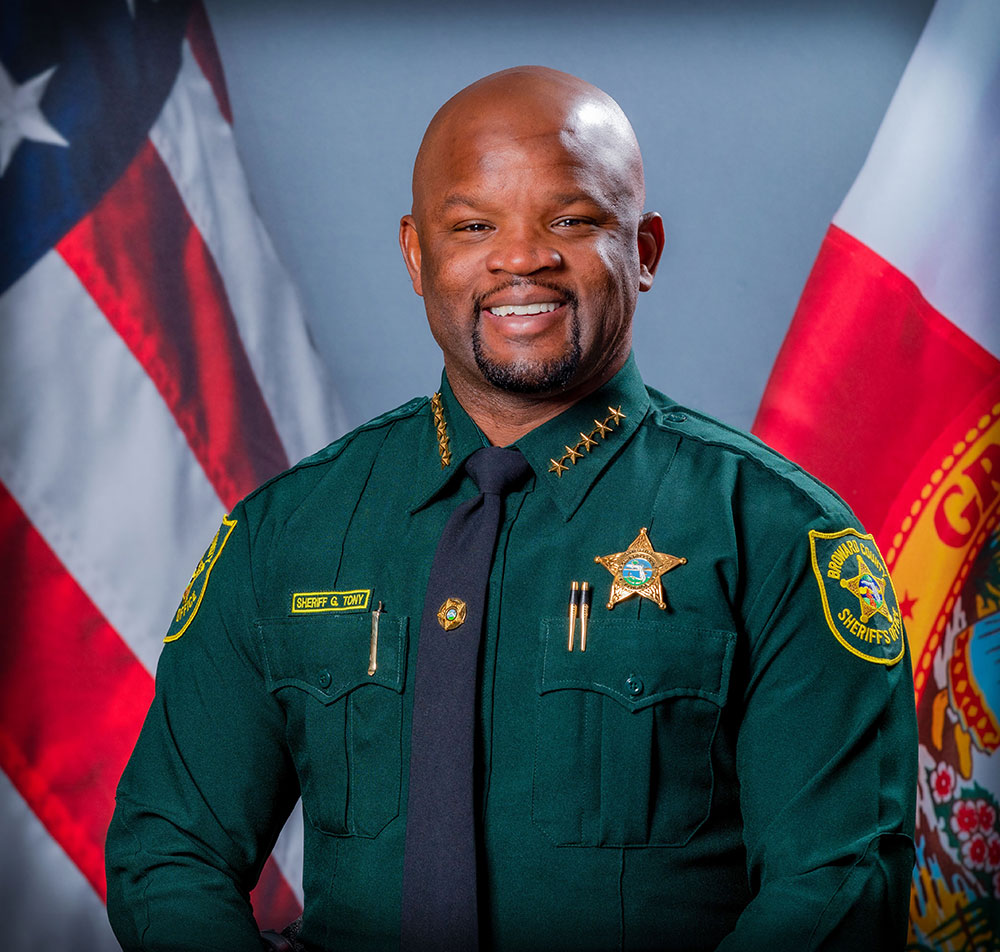
When confronted with the story, Tony said he had been found innocent because he acted in self-defense, fending off an armed attacker. But it turns out the Philadelphia police investigation was shallow, and Florida Bulldog recently learned that several witnesses who were never called in the trial said Tony was not threatened. The victim was unarmed and Tony, after a street argument, took his father's weapon and shot the victim a number of times. Those witnesses thought they had witnessed a murder. That story was picked up in detail by the Sun Sentinel.
A story that to Christensen's knowledge has not been picked up by the Sun Sentinel or any other organization is his latest report on a subject he has pursued for years - the 911 attack. Christensen and Irish reporter Tony Summers got on that dramatic story when they learned that the 911 hijackers were aided by prominent Saudis living in Sarasota during the period when the hijackers trained for the attack. Christensen discovered that such contacts were known to the FBI but withheld from the 911 commission headed by former Governor and U.S. Senator Bob Graham. The government has released information in stages, but only after freedom of information lawsuits and constant prodding by Christensen and others.
Information, obviously known by the government for years, was recently quietly released. It effectively admitted that factions of the Saudi government provided assistance to the hijackers. It is hard to believe that these revelations have not gotten national attention.
Another interesting detail in released documents was reported recently by Christensen. It involves planes that appear to have been headed for disaster, but never got off the ground when flight controllers froze all takeoffs after the first planes struck the World Trade Center. One such plane was Delta flight 23 which was in the takeoff line at JFK Airport in New York. The pilot of that plane, Tom Mannello, was interviewed by Christensen. He recounted that when he heard an airplane had struck one of the Manhattan towers, he assumed it was an accident involving a small plane. Then came a second attack and word from Delta's flight dispatcher in Chicago communicating with Delta's 16 coast to coast flights. When advised of the Trade Center attacks, he warned pilots to protect their doors. Even though still on the ground, Mannello, immediately did that. When he warned flight attendants not to try to enter the cockpit, he was told the chilling information that four young Arabs were seated in first class. The plane taxied back to its gate and passengers got off. There was no word what happened to the four young Arabs.
The dispatcher who issued that warning was Ed Ballinger, who now lives in the Florida Keys. He has been haunted by the fact that information on the attack was slowed reaching him due to a communications problem. Had he issued his warning just minutes earlier, the pilots of Delta Flight 93, which crashed in western Pennsylvania, might have been able to fortify their door and prevent the hijacking. That was the plane where heroic passengers rushed the cockpit when they realized they had been hijacked. In the melee that followed, the plane went out of control.
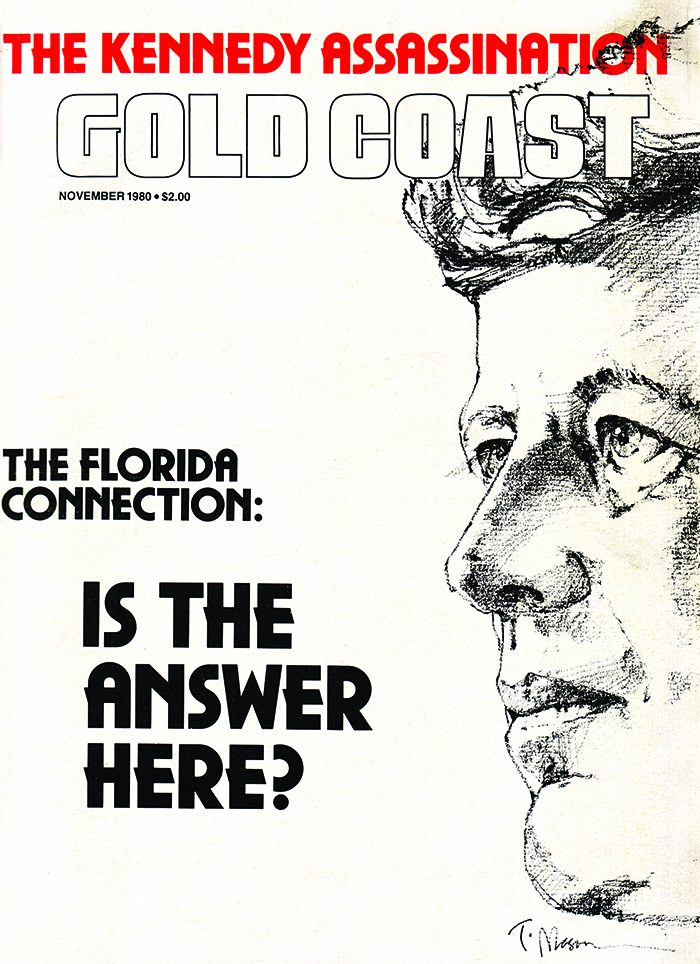
Gaeton Fonzi established a connection between Lee Harvey Oswald and the CIA's anti-Castro leader in a three-part Gold Coast Magazine series.
Government concealment of dramatic information is unfortunately not new. We still don’t know key details of the Kennedy assassination. That is close to this writer’s personal history. Our former partner in Gold Coast Magazine, the late Gaeton Fonzi, began working that story in 1965 when he reported in Philadelphia Magazine that Arlen Specter (later a U.S. senator) could not explain his own “magic bullet” theory, the only way the Warren Commission could conclude that Lee Harvey Oswald acted alone.
Pennsylvania Senator Richard Schweiker recalled Fonzi’s work and hired him when he headed a committee reopening the investigation in the mid-1970s. As the primary investigator working in Florida, Fonzi, through anti-Castro Cubans, made a link between a top CIA man and Oswald shortly before the assassination. It confirmed Senator Schweiker’s view that Oswald had “the fingerprints of intelligence all over him.”
It is a long story, but that investigation was sabotaged by CIA friendly congressmen, when it began to question the CIA. Fonzi wrote most of its final report which concluded that there was a conspiracy (meaning Oswald was not alone) but left the conspirators unnamed. Disgusted, Fonzi wrote a book, “The Last Investigation,” which made a compelling case that the CIA was behind the murder of an American president, and that the original Warren Commission was a sham, controlled by the CIA and an accommodating FBI. The story first ran in Gold Coast and The Washingtonian magazines. It got almost no attention from the major media. And yet, when Fonzi died 25 years later, the New York Times called his book one of the best written about the assassination.
But still, JFK’s death remains largely mysterious. The government, as with 911, admits it knows more, but refuses to tell us.
Almost 70 years after the assassination, people, especially the young, ask why would anybody want to kill such a popular American president? Answer: He was not popular everywhere. The CIA, controlled by Allen Dulles, who had been fired by Kennedy after the Bay of Pigs fiasco, hated him. J. Edgar Hoover, who headed what at the time was a very political FBI, had a widely known distaste for the Kennedys.
At the time both the CIA and FBI were out of control, unaccountable in many respects. President Harry Truman, whose administration saw the CIA’s birth, later realized it was exceeding its purpose as an intelligence gathering organization. The CIA had become a shadow government, involved in coups and assassinations of foreign leaders, and often controlling U.S. policy. President Eisenhower also had seemed concerned about the CIA’s unchecked power. But Kennedy was the first to do anything about it. He spoke of dismantling the spy agency. Then he fired Allen Dulles, but Dulles still secretly ran the spy agency.
That was after the close call in Cuba, when the U.S. found Russia building missile sites there. JFK tried to end the cold war. He also wanted to limit U.S. involvement in Vietnam, which he foresaw as the disaster it turned out to be. These were the opposite of the CIA’s goals, and it considered Kennedy not only a threat to its very existence, but also a dangerous traitor. Hoover at the FBI felt much the same.
Both the CIA and FBI were so arrogant with power that their leaders thought they could murder an American president and get away with it.
And they did.
A while back, when the Democrats’ chances in Florida looked bleak, we sought out Donald Trump in a dream. We asked him to forget party lines for a minute and pretend he was using his rare gift for lying to suggest ideas the Democrats could use in Florida's November election. He said that was easy, just say the Republicans want to kill Social Security and Medicare. Florida's seniors, many of whom are heritage Republicans, would go crazy. There was even some basis for such an absurd claim. Senator Rick Scott had actually mentioned the need for reforming social security. Trump said the Democrats should jump all over that and make people like Marco Rubio and Ron DeSantis deny that possibility at every interview. They hate socialism, but aren’t both programs a form of socialism? The GOP claimed they were and voted against social security in the 1930s and Medicare more recently.
Well, dreams can come true, to coin a phrase. There have actually been recent ads by the Democrats urging voters to resist Republican efforts to tamper with these popular programs. So far, the Republicans have not been confronted by reporters asking about this subject, but that is partly because Republicans have been avoiding the mainstream press, in favor of Fox News and a few cable channels whose distortions border on criminality. Governor DeSantis has even banned the press from some of his news conferences. That would end if the press retaliates by refusing to cover him, but that won't happen because most of the mainstream press have the bad habit of being dedicated and honest.
If Social Security and Medicare become a real issue, we can expect Republicans to react as they are doing on other issues. When Democrats say refusing to accept election results is anti-Democratic, they say it's the other way around — the Democrats are the ones trying to kill democracy by denying Trump's victory. Look for them to say Democrats want to kill social programs and good Republicans (who voted against them) want to preserve Social Security and Medicare. They call it alternative truth.
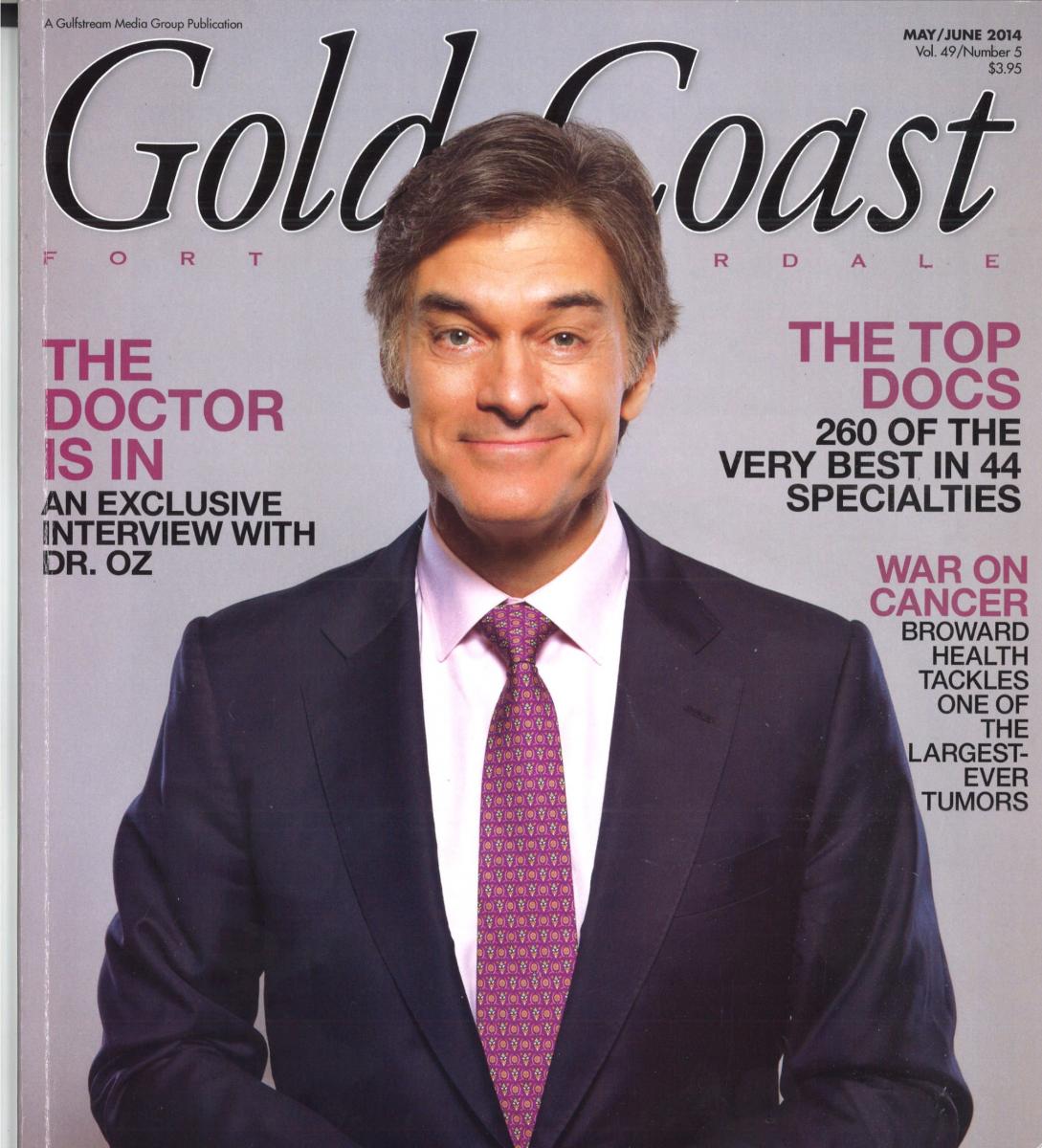
While on the subject of politics, we are downsizing our office and reluctantly discarding some old copies of Gold Coast Magazine, which we sold in 2019 after publishing it for 50 years. Among those copies we saved is a 2014 issue with Dr. Mehmet Oz on the cover. Dr. Oz is not a Floridian, but he was visiting at the time, and Jennifer Tormo knocked off a nice little piece on this national figure. And here we are, eight years later, and the same man is running for the U.S. Senate in Pennsylvania. As we write, his campaign is in big trouble, partly because it has been revealed that he doesn't even live in Pennsylvania, rather New Jersey. The other problem is that the man has no political experience, and his opponent is a seasoned pro. Dr. Oz is running strictly on the strength of being a national television figure. And what person in their right mind would say being a TV personality qualifies a person with no government experience to represent an important state in these turbulent times?
Maybe Donald Trump has an opinion on that.
The memorials to actor James Caan, who died last week, largely featured his Mafia identity in the classic "The Godfather" film. But they also noted a role that to many in South Florida defined the actor's many cinematic achievements. That would be playing Fort Lauderdale native Brian Piccolo in the film "Brian's Song."
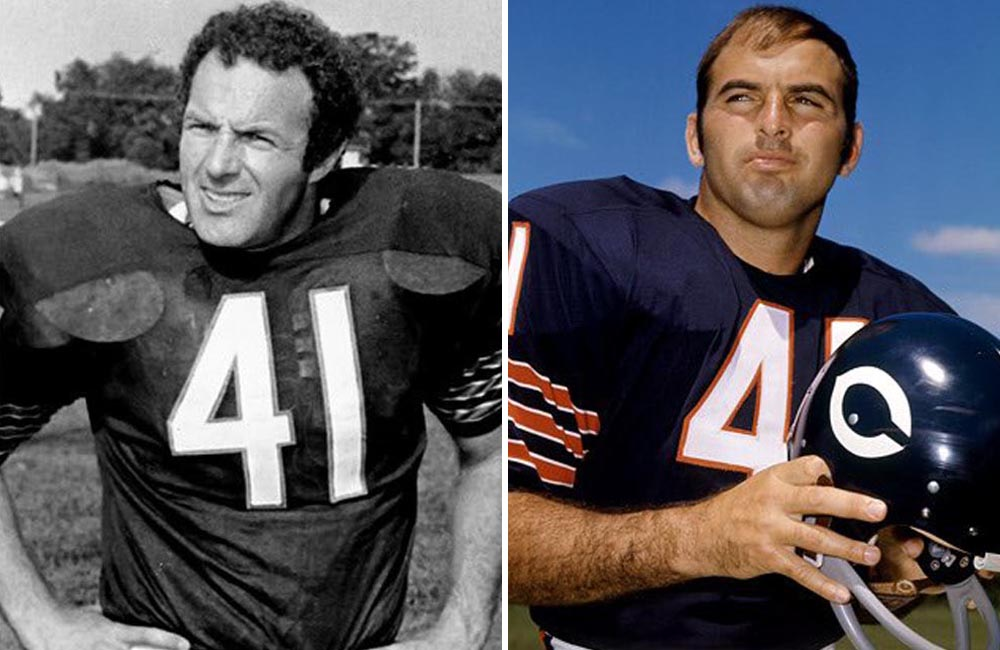
Pictured: James Caan (left) and Brian Piccolo (right)
"A lot of my local friends think that was the top his career," Dr. Dan Arnold said this week. It certainly was for Arnold, who was one of Piccolo's closest friends and played in the backfield with him at Central Catholic (now St. Thomas Aquinas High School.) For him, the role as the man they called "Pic" in the now iconic "Brian's Song" was more relevant than Caan's subsequent star fame as Sonny in "The Godfather" and other films which usually cast him as a tough mobster. Caan had been acting for several years, and had gotten some good reviews, but he was largely an unknown until he played Brian Piccolo.
The 1971 film was timely - Piccolo had died only a year before - and his outgoing personality had made him a favorite of his Chicago Bears teammates and fans. "Brian's Song" far exceeded the modest expectations for it. Its story was so inherently touching, combining the unusual friendship between the great Chicago Bears black running back, Gale Sayers, and Piccolo, who was mostly his backup, with the wrenching story of Piccolo's death from cancer at age 25. It has become a classic of its genre, still being shown occasionally on TV and still bringing audiences to tears.
Jeanne Morris, wife of a Chicago Bears player, wrote "A Short Season" upon which the film was based. She recalled that there wasn't a dry eye in the house when the Bears players first saw the film. Dr. Arnold was no exception.
"I saw it with my wife and father-in-law at their home in Tennessee," he recalls. "It was emotional. I didn't want to cry, but I looked over and saw my father-in-law and he had tears in his eyes. So I knew it was okay to cry."
Caan and Billy Dee Williams, who played Gale Sayers, both caught the spirit of the men. Caan's sudden rise to prominence helped land him the memorable role in "The Godfather" just a year later.
"The Godfather" made people think Caan was Italian for the rest of his life. He was actually Jewish of German ancestry. A bit older than Piccolo, he looked athletic enough to be a football player. And Dr. Arnold thought he captured Piccolo nicely. "His mannerisms, how he talked, he did a good job," says Arnold. For Arnold, the only discordant note in the film was the scene where Piccolo is dying.
"I knew Brian so well, and he was pretty worn out when he died. He lost so much weight. He wasn't the Brian Piccolo we all knew. Caan looked like a healthy man. But it was still a heartfelt movie."
Piccolo's death and the film had such impact that the medical community concentrated on curing embryonal cell carcinoma, deadly in 1970. Drugs were refined to battle that rare form of cancer. It is now 95 percent curable.
Dr. Arnold recalls Piccolo's soaring ambition as a teenager, even before he went on to star at Wake Forest and make it as a pro. He says Piccolo could not help but relish his enduring legacy. And he would probably delight in what has become of his backfield teammates at Central Catholic. He played halfback. The other halfback was Dr. Arnold, now retired, who became a leading children's dentist in Fort Lauderdale. The quarterback on that team was William Zloch, who went on to play at Notre Dame under Ara Parseghian and is now Senior United States District Judge for the Southern District of Florida. The fullback was John Graham who recently died. He was leading sales executive in the Nabisco Company organization.
Football legend aside, you would have to search a long way to find a more distinguished high school backfield.

Musk could learn a lot from Kinney.
It appears that the Fort Lauderdale City Commission is moving forward with the futuristic plan for the Elon Musk tunnel from downtown Fort Lauderdale to the beach. As previously written here, this is disturbing on several grounds, not the least of which is that few people support what seems a highly problematic concept. The Sun-Sentinel quoted one citizen who objects to the tunnel as saying she knows no one who thinks it is a good idea. Second that thought. I don't know anybody either. In fact, with newspaper readership in decline, one wonders how many people even grasp the concept.
At first glance, the idea of a tunnel to relieve the traffic bottleneck leading to the Las Olas Boulevard's access to the beach seems praiseworthy. That is, if it were a real tunnel — one in which people could drive their cars under the existing problem, much the way the Henry E. Kinney Tunnel takes U.S. 1 drivers under the New River. But I wonder how many people understand this is not that kind of tunnel. This is a special design used to accommodate only special Tesla vehicles. It is a good idea for connecting an airport to a nearby population center or mass transit facility. It is a fast version of a bus between two points. But the current traffic problem is not one that buses or any form of existing mass transit can solve. If it could, the problem would be solved already.
Rather, the problem is people who need to drive their own cars. If those people were all going to the Brightline station (the proposed western terminus) or to the Elbo Room on the beach, it would be one thing. But that traffic consists of people going all over the beach at one end and in countless directions from downtown at the other. They need their cars to complete their trips. What are they supposed to do — rent a car after they leave the tunnel?
Common sense tells us the tunnel users would largely be tourists, and they aren't the obvious source of the congestion. You would think the first thing the city would do is survey those now causing the traffic problem, to find out where they are going and whether they would use the tunnel. Do this before any money (and nobody knows how much) is spent planning and executing the novel Musk concept.
At the same time consider the feasibility of a real tunnel between downtown and the beach. As written here before, it could be much shorter, and presumably a lot cheaper, connecting Broward Boulevard to the beginning of the Las Olas Isles, either beneath the very busy 15th Avenue (where the worst gridlock occurs) or from the point where Broward turns north into Victoria Park Road, and then just four blocks south under the existing canal to Las Olas.
You could call it the McCormick Tunnel. if Musk wants to build it, add his good name to the project.
Photo credit: formulanone from Huntsville, United States, CC BY-SA 2.0 <https://creativecommons.org/licenses/by-sa/2.0>, via Wikimedia Commons
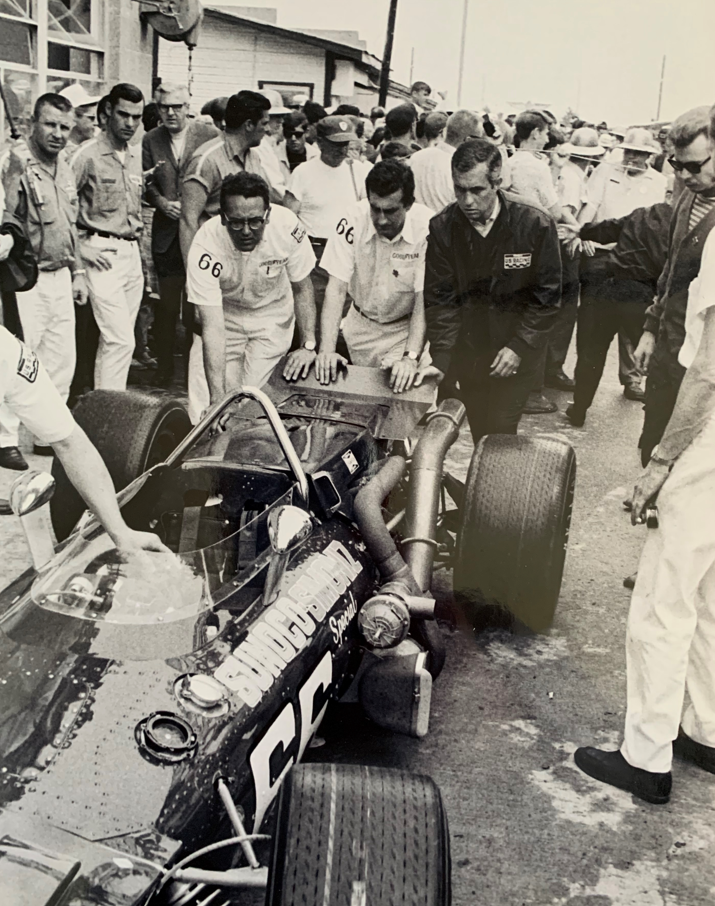
Roger Penske was a hands-on manager. He helps push his racer to the garage. (Bernard McCormick carried an early pocket camera. His photos accompanied his story.)
Alan Halpern, editor of Philadelphia magazine, was not a big sports fan. But he knew many of his upscale business audience were, and one of the reasons he hired me may have been my background as a newspaper sports writer.
In any event, the magazine began doing sports articles in the mid-1960s. We went to Florida for spring training with the Phillies when Gene Mauch was the innovative manager and Dick Allen its star hitter. We spent time with the Eagles during one of its less memorable fall seasons, and later traveled with the 76ers when they had a championship team with star Wilt Chamberlain. We visited Canada pre-season to welcome the Flyers bringing big time hockey to Philadelphia, and went out on the water with Philadelphia's Vesper Boat Club after they had won the Olympic eight race.
Halpern also cooperated with the ad boys to attract business, and thus it came to pass that we lucked into a story on a local boy with big promise in auto racing. Having bought a Porsche (only $2,600 — used but in great condition), I had an interest in sports cars. You would not mix that car up with later Porsches. It had only a 90 horsepower rear engine, but it was great fun to drive and impressed people who knew what a Porsche was. The German firm had just entered the U.S. to compete for the youth market with British sports cars such as MG, Triumph, and Austin-Healey.
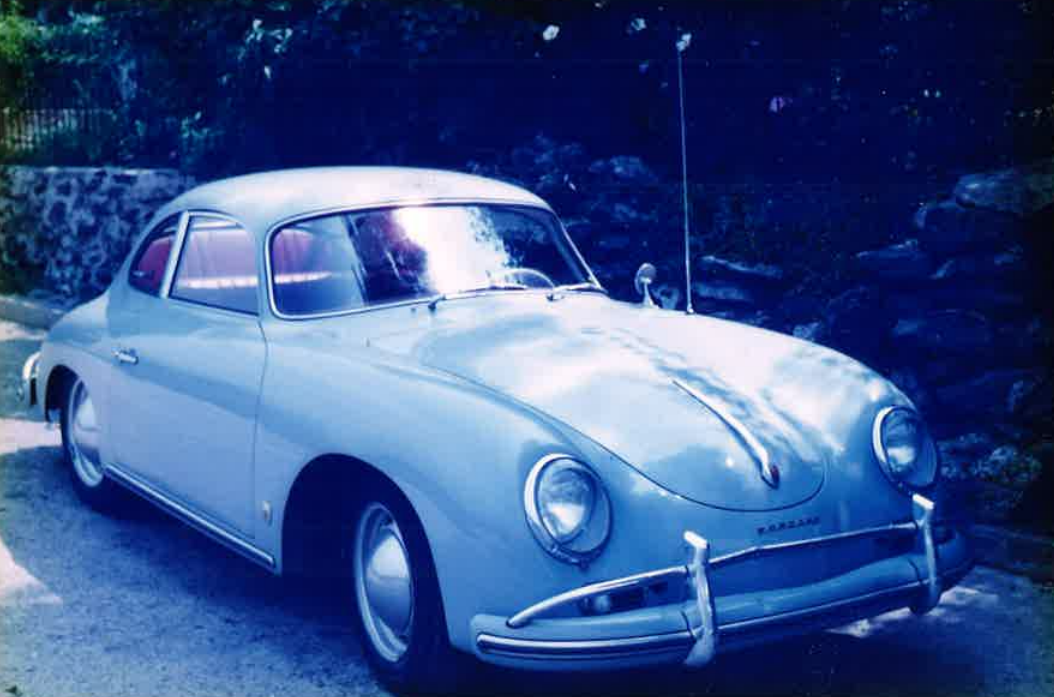
McCormick drove a used 1958 Porsche at a time when its now-familiar shield logo was little known in the U.S.
Roger Penske’s name had been mentioned in the Philadelphia papers since he began racing while still at Lehigh University. He became one of the best drivers in the sports car field, driving various cars including a Porsche. He did this while entering the business world. He stayed close to cars, first as manager of a Philadelphia Chevrolet dealership, then as the owner. Although he gave up driving, he managed a sports car team which had great success with a young driver named Mark Donohue. By 1969 their reputation was enough to warrant serious press when they announced they were going to take a big step up by entering the biggest race of all, the Indianapolis 500. It was a new form of racing, an oval track, much different from the serpentine, undulating sports car venues with their constantly changing speeds. Sports car racing had a limited fan base, whereas Indy was one of the great events in sports, attracting live crowds in the hundreds of thousands.
For Philadelphia magazine, it was a made-for-order story. It involved cars, whose advertising we sought. It focused on a young local man rising in business who had shown his acumen by landing Sun Oil as his principal sponsor. That firm was a local giant whose office was just around the corner from the magazine, and its PR man was a friend from the newspaper business.
Roger Penske could not have been more cooperative. Although I had owned a Porsche, I had never seen an auto race of any kind. I probably told Penske that, and he gave me a pretty good education. I visited his racing headquarters in suburban Philadelphia, and the facility where his novel four-wheel drive Lola was being prepared. I made several trips to Indy, including the rookie qualification weekend, and flew in Penske’s rented plane.
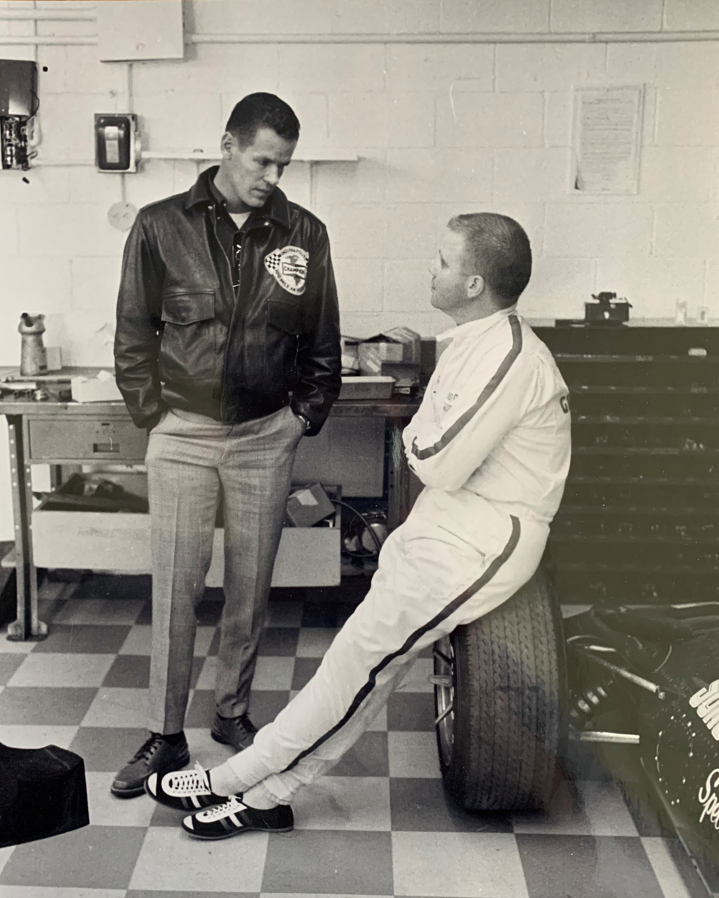
The team’s garage was a parade of reporters and racing notables. Bobby Unser, who had won the previous year, visited Mark Donohue.
Penske and Donohue commanded remarkable attention for newcomers. Their garage, which he kept immaculate, was constantly crowded with reporters and prominent racing figures. Compared to typical Indy teams, they were viewed as college boys from elite schools. (Donohue had an engineering degree from Brown.) They both already had nicknames. Our story was titled “Captain Nice and Mr. Clean at Indy.” Penske’s obsession with neatness and detail and Donohue’s soft-spoken and pleasant style preceded them.
After qualifying with a fast time, their car started in the second row, and was running third when an engine problem cost them time in the pits and led to a sixth place finish in a race won by Mario Andretti. Penske’s work did not end that day. I wanted one more visit with him and he met me the day after he returned to Philadelphia in his office — at 7:30 in the morning. He was signing 130 thank-you letters that had been prepared in advance. He said it did not take much time and people appreciated it. One sensed a man destined for distinction.
Penske had estimated it would take them three years to win at Indy; he was off by a year. Donohue won in 1972. His career and very close relationship with Penske ended when he died in a practice accident three years later in Graz, Austria. A blown tire sent him into a track barrier. He did not appear to be injured. He complained of a headache and died the next day from a brain injury. Roger Penske went on to win a record 18 times at Indy with various drivers and car manufacturers. Nobody else is close. His work off the grid has been just as impressive. His company owns various businesses, including truck leasing, collision centers, hundreds of auto dealerships (a number of which are in Florida), and even a media company. His companies reportedly employ over 60,000.
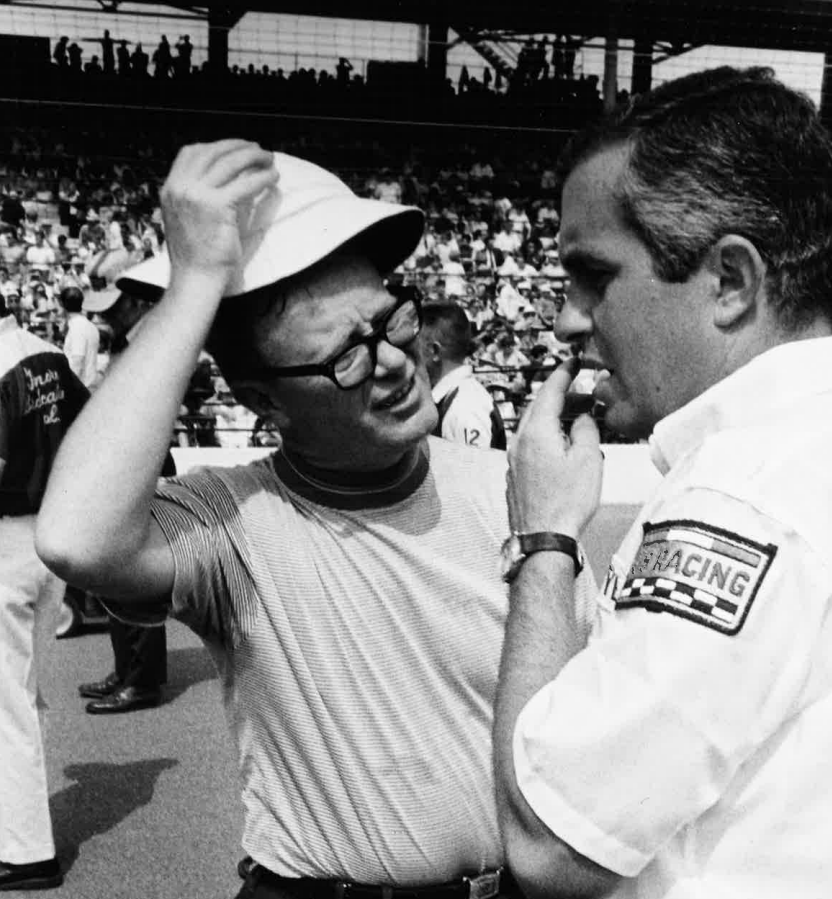
Penske had a deft and gracious touch with the media. He is interviewed by Philadelphia columnist Sandy Grady.
In recent years his empire included a special acquisition. In 2019 he purchased the Indy 500 and the IndyCar series. His development of the Indy 500 was delayed by the Covid epidemic, limiting the size of its Memorial Day crowds, but this year it was back on track with 300,000 in attendance. I have tried to watch the Indy 500 every year since that memorable 1969 race, rooting for another Penske winner. But last Sunday was special, with the race celebrating its new owner. Roger Penske, still active at 85, gave the storied command: “Drivers, start your engines.”
My thoughts went back 53 years to that weekend in Indianapolis. One of the numerous sports writers following his team marveled at all the fuss being paid to this impressive newcomer to auto racing’s biggest event. Watching Penske’s poise while being interviewed by a national TV figure, he dropped a comment.
“You would almost think he owned the place.”
Did you know that after more than 20 years of investigation, the FBI recently released files revealing that important Saudi Arabian government figures, including religious leaders in the United States, were behind the 9/11 attacks?
You didn't?
Well, you will pretty soon — as soon as someone in our mainstream press realizes those FBI reports exist and publishes the explosive information.
Meanwhile, if you can't wait, look up the Florida Bulldog website and Dan Christensen's discovery of the FBI report, which appeared in March, buried in voluminous documents released by the bureau. That hardly seems accidental.
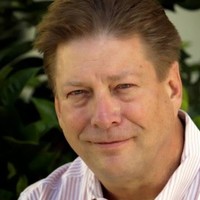
At least it would not seem accidental to Christensen, who has been on this story since 2011. He and a few others uncovered information on the source of the 19 hijackers financing long ago, and challenged the FBI repeatedly to reveal what it failed to tell the 9/11 Commission when it published its investigation in 2004. Christensen's main contribution was finding links to a highly connected Saudi Arabian who was living in Sarasota and had ties to the hijackers who trained in Florida. That family left Florida suddenly just before 9/11, disappearing so fast that it left cars and other belongings behind.
The FBI material reveals a maze of contacts with unfamiliar names who appear to have financed the terror attack. For the average reader it would take knowledge of Arabic and the complex structure of Saudi Arabian leadership to begin to follow it all, but the bottom-line is that the Saudi Arabian government was deeply involved in that tragic day, September 11, 2001, when almost 3,000 Americans died in attacks on the World Trade Center and the Pentagon, and a failed attempt to attack what was believed to be the U.S Capitol. The FBI report comes after Christensen and a handful of others relentlessly pursued the FBI to reveal all it knew. That it took so long, and has come out in such a sneaky fashion, suggests that several administrations since 9/11 were party to concealing the truth. Former Attorney General Bill Barr admitted as much when he declined to turn over 9/11 documents to the Bob Mueller probe on the grounds that they were “state secrets.” It was not until President Biden’s presidency that the government has become transparent on such issues.
Christensen, whose Florida Bulldog report appeared over the weekend, explains the odd circumstances surrounding what he termed "A state secret no more."
"It was released in March" he says. "But it's buried amid thousands of pages of stuff the FBI has been releasing. So no surprise no one's found it yet.
The surprise is that no mainstream media are reporting about any of these documents, and the sensational stuff that's in them."
Christensen is used to his dramatic work being ignored. The Miami Herald, for whom he once worked, has picked up and credited some of his research, but not many other outlets have given the story the attention it deserves. Florida Bulldog routinely publishes stories that the mainstream press neglects. It is one of several organizations around the country filling a void left as newspapers and print in general declines. These groups are headed by former journalists who have taken buyouts or retired, and their support comes from contributions from peers who believe in a free and dedicated press.
Most of the recent press has painted a grim picture of the Democratic Party's chances, both nationally and in Florida, for the fall elections. But the respected longtime political columnist Steve Bousquet offered a little hope for the Dems in last week's column in the Sun Sentinel. Bousquet said two recent events may prove so unpopular for Republicans that the Democrats might use them to reverse the fall tide.
Bousquet wrote that the leaked Supreme Court abortion ruling and Governor Ron DeSantis’ pledge to sign an open-carry gun law both run contrary to Florida public opinion, and if the Democrats pound both issues home it might make the difference in the upcoming election. Bousquet went so far as to say he could not imagine two more powerful issues as gifts to the Dems.
Not so fast, Mr. Bousquet.
There is another issue, or two, that might eclipse those as election fodder for the underdogs. And they come directly from former President Donald Trump — or at least they did in a dream that seemed to be inspired by Bousquet's column. In sleep, Mr. Trump was encountered in a Palm Beach bar.
"Where do I know you from?" was our safe conversation opener.
"I used to be President around here," he said.
"Oh sorry, I didn't recognize you without an orange jumpsuit. But you're just the man I was dreaming to meet. I know you are proud of your reputation for never telling the truth on purpose, especially when it comes to stolen elections, and some people wonder what you would advise the Democrats to do to steal the next Florida election. Forget party stuff for a minute."
"That's easy," Mr. Trump replied. "I'm surprised nobody consulted me before. The Democrats should simply say that Republicans are going to repeal Social Security and Medicare."
"Are they really?"
"Of course not, but what difference does it make? Truth has nothing to do with anything. And all the retired old people who love me would go crazy. That's the two things that matter even more than abortion or guns or stolen elections to that group of voters. They'll go crazy if you even mention touching Social Security or Medicare."
"But won't the Republicans deny it?"
"Of course they will, but that's exactly the point. But you just keep asking them every time they show up anywhere if it's true they are doing away with Social Security and Medicare. The more they deny, the more people think they are hiding something. Notice that's how I work. I start a rumor by saying 'a lot of people are saying...' even if nobody is saying it, and then I repeat it every five minutes, until gullible people believe people are actually saying whatever it is I say they are saying. Works every time. Besides, there is some truth to the Social Security and Medicare stuff. Senator Scott actually said something close to that in his recent plan to get elected. And they all have voted at one time or another against expanding social services. They cry 'socialism' and it scares people to death."
"Very clever, Mr. Former President."
"And when they insist they won't repeal Social Security and Medicare, you say they must be for socialism like they have in Cuba, because those two programs were condemned originally by Republicans as socialism, and how could they be for socialism when they are against socialism. They will get all frustrated and forget what they believe, if they believe anything."
"Does this mean you would endorse Democrats if they give you credit for your advice?"
"You must be dreaming."
"In fact I am, and it's time to wake up to reality."
“Please do, and feel free to share my advice with Mr. Bousquet and the other fake news specialists at the Sun Sentinel.”
A Philadelphia Cowboy in Disneyland in 1957
It was the summer of 1957, and after ROTC camp at Fort Sill in Oklahoma, a few of us headed for our first trip to California. One of the guys had Los Angeles relatives who would put us up. One of the first things we did was visit Disneyland, the new theme park everybody was raving about. It was mid-August. We met some girls who worked there who told us all the local guys were quitting to return to school and we could probably get jobs. We did. A young fellow named Ron Dominguez, whose family owned the land where Disneyland was built and went on to become a top Disney exec., hired us when we promised to stay until Sept. 15. We did not need to be back at La Salle in Philadelphia until the 20th.
Those six weeks were great fun. Romeo (his real name and he lived up to it) had the best job: A speaking part on the Mark Twain river boat. Mitch and I became cowboys, loading the stage coach and mule train in Frontierland. When not working, we roamed the park, which was an endless delight, and dated some very pretty co-workers. Walt Disney’s face was not well known at the time, but he was all over the park noticing every detail, including the fact that one of the workers on the mule train ride was not ripping up the tickets when he boarded the young riders. There was also some drama in September when the ponies pulling the stagecoach got spooked, bolted out of control, and turned the coach over sending dirt covered riders sprawling all over the trail. Fortunately, the worst injury was a broken arm, but that was the end of live rides at the park.
It was only the second year of Disneyland, and it was about the only thing in Anaheim. The Snow White castle was a landmark in the area. The early morning drive from Monrovia, east of L.A. where we stayed, was 34 miles to the park along empty roads much of the way with the softly purple San Garbriel mountains on the left. There were several housing developments near the park and only a few attractions, such as Knott’s Berry Farm. Disneyland was responsible for most of the traffic which was generally light.
I did not get back to California for five years and was amazed at the changes around Disneyland. There were all kinds of development, a lot of it down scale, and the roads were busy. The fast drive from Monrovia was now interrupted by stop lights. The changes were depressing, but not as depressing as several trips over the years when development, including high-rise buildings, hemmed in Disneyland. On the last trip, about 10 years ago, I could barely find the park even when a few blocks away. The landmark castle could not be spotted until you were almost on top of it. The ambiance of 1957 was long gone.
It was obvious by then why planning for Disney World involved a huge parcel of land so the company could prevent the mistake in California: Development crushing the Magic Kingdom. That reality was widely known at the time. The special taxing district given to Disney World made complete sense. Disney paid for the roads and infrastructure at Disney World and had room to expand over the last four decades. Repealing that special status, and the tremendous problems it will cause if actually effected (which I strongly doubt), shows the ignorance of the DeSantis Republican toads now governing our state.
It is especially disturbing that Ron DeSantis made the move because he objected to the Disney people making a comment on a cultural matter—an example of his Trumpian tendency to punish those who cross him. The Republican support reflects a national trend of many of its elected officials embracing power over principle.
It makes one wonder what happened to Republicans such as E. Clay Shaw, Joel Gustafson and Jeb Bush.
